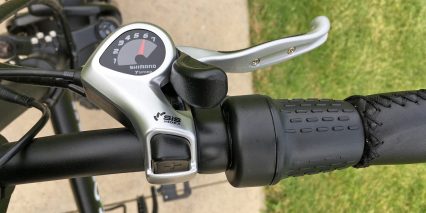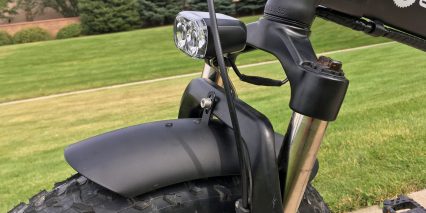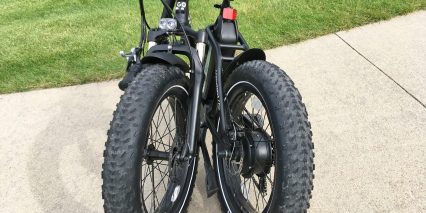To run the forums, host the website, and travel, I charge a universal service fee for my reviews. This review was sponsored by Go Power. My goal is to be transparent and unbiased, this video and written review are not meant to be an endorsement of Go Power.
Go Power is a new company when it comes to EBR reviews and they offer a sizeable fleet of electric bikes, scooters, and even skateboards. Today’s bike is the Go Express, a folding fat tire bike equipped with fenders and an integrated headlight that come in only one frame size but your choice of two colors (black or white). This is a value-priced bike at $1250 with a one-year comprehensive warranty, and you also get free shipping if you live in the lower 48 states of the US. As expected we do have some more entry-level components that help to keep the cost down, but we’ve also got some nice upgrades (that we’ll talk about later) and nice sturdy construction of the folding frame. The fat tires from Kenda have a range of 5-30psi, so you can drop that pressure down to the 5-10psi range to handle more difficult terrain such as snow or sand. Dropping the pressure down like that also gives you a more comfortable ride, which I love doing – just be aware that a lower pressure means you won’t get as much efficiency and range! These tires have reflective sidewall striping to increase visibility which I appreciate, but they don’t have any puncture protection aside from being fat tires which are naturally somewhat puncture-resistant. While test riding this bike I kept my rear tire lowered to about 15psi which along with the suspension fork in the front made for a really comfy ride. I like this suspension fork, it offers 100mm of travel and adjustments for preload and lockout, and it performed great during my extensive riding adventures. This bike was shipped to me which means I got to spend a lot of time with it, cruising around on a variety of terrain types and even doing a long-distance ride of about 30 miles. The Go Express performed admirably for that long ride, although I would recommend investing in a more comfortable saddle if you plan on riding that far. The provided saddle is fairly basic and a bit firm for my liking, although it would soften up a bit with more use and works just fine for shorter rides. As a side note on the shipping, these bikes ship almost completely assembled, and it took me about 30 minutes to get it ready to ride using the included toolkit and air pump.
The Go Express is powered by a 500 watt Sandra geared rear hub motor, which peaks at around 750 watts. The smaller 20″ diameter on these wheels means a greater mechanical advantage for the hub motor, and I found that it had plenty of power both for climbing hills and for cruising on throttle only – for some context, I am 6’3″ and weigh about 190 pounds. The motor can be activated by the twist throttle on the right grip, and it is a variable speed throttle, which I appreciate since this motor really does have a lot of zip at the highest power setting. Speaking of those settings, you get 9 different power levels that apply to both the throttle and to pedal assist, with the option to go to level 0 and have no power assistance (handy when maneuvering the bike to make sure nothing bad happens if you bump the throttle). Pedal-assist detection is handled by a 12 magnet cadence sensor, and while it performs great I do want to call out that it is not a sealed sensor. It is placed on the inside of the chain guide and reasonably well protected, but it is still vulnerable to being bumped which could cause a magnet to fall out or the sensor to get bent. You’ll want to keep an eye on that and inspect it regularly to ensure smooth riding operation. For human power we have a 48-tooth steel chainring in the front with a nice big plastic chain guide that does a great job both at keeping pant legs out of the chain and at keeping the chain from falling off should you go off a curb or over bumps. We have a 7-speed cassette in the rear with shifting handled by a Shimano Tourney derailleur, which is an entry-level setup from Shimano. I found that shifting with the thumb shifter on the right handlebar was a smooth affair, I didn’t have any problems shifting up and down the full range and everything was perfectly tuned from the get-go.
The battery here is made by Go Power and it is a 48 volt 10 amp-hour battery which means 480 watt-hours of power. It is mounted behind the seat tube which unfortunately means you do need to fiddle with the seat post quick-release skewer to remove the battery, but you can get around this by rotating the skewer about 90 degrees counter-clockwise and tightening it there. I got great range results from this battery on the long-distance ride that I mentioned earlier. I used high levels of pedal assist (alternating between 6 and 7) for about 75% of the ride, and the remaining 25% of the time I was cruising along using only the throttle… and I still made it back home with over 20% of the battery remaining! Go Power estimates 20 miles when using the throttle and 36 miles when using pedal assist, so it’s great to see that the Go Express can live up to those numbers. The battery has an on/off switch and the charging port facing the right side, as well as a button and LED readout on the back so that you can quickly check the charge level. The charger is a basic 2 amp charger, this is the standard for most Ebikes and it is easy to transport in a backpack at 1.4 pounds. Connected to the battery is an integrated Blazelite 2-LED headlight, a great feature to see on a value-priced bike like this. Lights tend to be in either the “see” or “be seen” category, and this light belongs in the former as it does a great job lighting up the road in front of you. Unfortunately, there is no integrated taillight, although we do get a reflector mounted on the seat post. That helps with visibility but it’s still worth investing in your own rear light if you plan to do any night riding.
The control system on the Go Express is fairly basic with a three-button control pad and the SW900 monochrome LCD screen. Press the center button to power up the bike, and then press it again to toggle between the odometer and the trip counter. You can use the up/down arrows to change between assist levels one through nine, or all the way down to 0 for no assist. The display readouts will change to show “eco” for assist levels 1-3, “standard” for levels 4-6, and “power” for levels 7-9. You can also turn on the headlight by holding down the up arrow, and holding down the down arrow will enable “walk mode” pushing the bike forward at a walking pace. You can hold the up and down arrows simultaneously to get into the settings menus, which are extensive and confusing – I wouldn’t recommend changing anything in here unless you know what you’re doing! We have the thumb shifter mounted on the right side, this is the Shimano SiS Index which has a gearing readout window in case you forget which gear you happen to be in. The grips are ergonomic locking stitched leather and I found them very comfortable, particularly on my long-range ride. We do, of course, have that twist throttle on the right, and also a flick bell on the left side. Stopping the bike is managed courtesy of the Tektro Aries mechanical disc brakes with 160mm rotors and single-piston calipers in the front and rear. These provide ample stopping power thanks to the large four-finger brake levers, which provide a noticeable mechanical advantage for these mechanical brakes. Keep in mind that mechanical brakes need regular maintenance and tightening to keep them performing at an optimal level, so be sure to take care of that if your brakes start feeling a bit loose or soft. One thing I want to point out regarding the handlebar is that while it is easily adjustable for height with a quick-release skewer, it is severely limited by the length of the control cables – you can only raise it up about 3 inches without really starting to stretch out those cables which can be dangerous while turning. For someone over 6 feet tall (like me), this can be frustrating, and I would have preferred to raise the handlebars up a few more inches… but for riders of average height, this won’t be a problem at all.
I put about 75 miles on this bike and really had a lot of fun with it, using it to cruise around town and also doing some off-road adventuring. One thing that stood out to me is the solid construction of this bike, there isn’t any noticeable frame flex or looseness in the folding joints, and riding always feels very grounded and stable. I rode down a steep hill that had me coasting at 35mph, and the Go Express felt perfectly safe and stable even at that speed! As I mentioned earlier we do have integrated front and rear fenders, these are made of aluminum alloy so they won’t scratch or ding like steel. Interestingly, these fenders seem designed to protect the bike more so than the rider… for example, the rear fender does a great job of shielding the battery and controller but doesn’t extend back far enough to keep mud or water from flying up and hitting you in the back. I’m glad the electronics are protected, just be aware of the coverage issue if you get caught riding in bad weather. There are bosses for adding a front rack, but unfortunately none for a bottle cage or rear rack. Folding the bike is simple thanks to quick-release controls, but maneuvering it while closed is more of a challenge. The Go Express weighs in at 60.2 pounds and doesn’t have any sort of latching mechanism to hold it closed, as well as not balancing particularly well on the bottom stand while folded, so you really need two hands to maneuver it around. It’s definitely not something you would want to bring on the bus or train while commuting, but it gets the job done for transporting it in your vehicle on a camping trip or for storing it indoors. That’s a tradeoff with any folding bike, of course; smaller and more compact bikes are easier to transport and maneuver while folded, but then you lose out on stability and ride comfort. The Go Express is definitely on the other end of the spectrum, providing great comfort and stability at the cost of being comparatively more difficult to handle for folding and storage, but still definitely manageable!
As always, I welcome questions and feedback in the comment section below. Whether you own a previous version of the bike, have taken a test ride, or are brand new to the space, my goal is to provide an objective and honest resource. You can also join the EBR forums and share your own photos, videos, and review updates to help others! Have fun out there, and ride safe :)
Pros:
- Great price point at just $1250 with free shipping in the lower 48 states of the US
- Kenda fat tires can tackle a wide variety of surfaces and add comfort, as well as good visibility from reflective sidewall striping
- Shimano 7-speed system shifts smoothly and offers good range for city or all-terrain riding
- Front suspension fork with 100mm of travel adds more comfort, and is adjustable for preload and lockout
- 480 watt-hour battery provides great range
- Plenty of power from the 500 watt geared rear hub motor from Sandra
- Integrated fenders and headlight, with bosses for mounting a front rack
- Sturdy construction with no flexing or looseness at the fold joints
- Solid stopping power from Tektro Aries mechanical 160mm disc brakes, thanks to large four-finger brake levers
Cons:
- The control cables aren’t long enough to fully raise the handlebar, but this will only affect very tall riders
- Quick-release skewer for the seat post gets in the way for battery removal, you can avoid this by rotating it 90 degree counter-clockwise
- The rear fender does a great job protecting sensitive electronics, but it doesn’t extend back far enough to protect the rider from dirt and water
- The cadence senor is not sealed and thus vulnerable to getting bumped or bent, but it does have high resolution with 12 magnets
- No bosses for mounting a bottle cage or a rear rack, but there are bosses for a front rack
Resources:





































Richard Hill
5 years agoHey Court, I enjoyed the review by Tyson on the gopower bike, hope see more reviews from him. Rich
ReplyCourt
5 years agoAwesome! I feel that Tyson does a great job, it’s so nice to have help from him and Mikey :D
ReplyLarry
5 years agoHow difficult is a bike like this that weighs what this one does to pedal with no e-assistance?
ReplyCourt
5 years agoHi Larry! Great question… In my experience, if you’re on flat ground and the tires are set to the recommended air pressure, most ebikes are pretty easy to pedal once you’ve got some momentum. If the tires are low, if it’s windy, if you’re climbing or trying to start out fast… that’s going to make it increasingly difficult. Also, since this one has larger tires with all-terrain tread, that could add some friction and drag which will make it slightly more difficult to pedal. I’m giving you the facts, but there are lots of factors here and to me, having ridden some ebikes unpowered… it’s very doable, but definitely hugely noticeable compared to using assist. It’s still faster, smoother, and easier on your knees than walking or running, but definitely more effort than a lightweight acoustic bicycle :)
ReplyKeyna Radtke
5 years agoDistance from seat to bottom peddle? It says 5’4″ rider. I’m interested in actual distance so I can determine if it will work for me.
ReplyCourt
5 years agoHi Keyna! We measure a couple of parts to help explain how “approachable” these ebikes are. For this one, we measured 25″ stand over height and 32.5″ minimum saddle height. This means how low the frame is where you “stand over” it, and how low the saddle can go in case you want to be able to touch the ground while seated. In my opinion, this is a very approachable ebike, and one that would fit petite riders fairly well. Plus, the fat tires add stability in case you’re new to cycling and want some extra support that way :)
ReplyTerry Crews
5 years agoAfter reading this review earlier today, then googling and finding the same review on youtube, I ordered two of these, One for me, one for my wife. We are both in our 70’s and so excited to have ebikes on the way!
ReplyCourt
5 years agoFantastic! Thanks for the update, Terry. We have been amazed with the number of fun fat tire products in the space, and the Go Power Go Express looked fun (a friend reviewed it, not me). I welcome any future thoughts and feedback in comments here from you. Glad you enjoyed our work and I hope that the bikes arrive safe and you have LOTS of fun together this summer :D
Reply